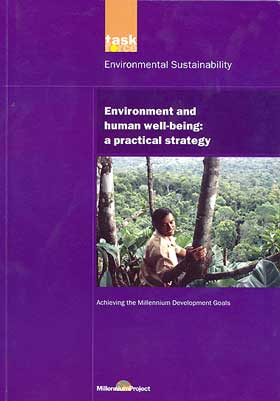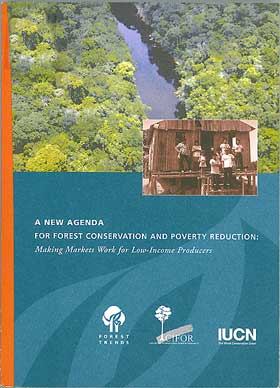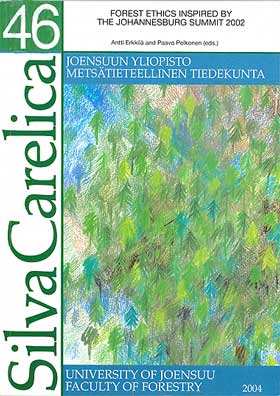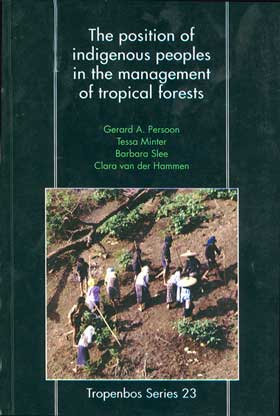


European Forest Sector Outlook Study main report. United Nations Economic Commission for Europe (UNECE) and FAO. 2005. Geneva, Switzerland, United Nations. ISBN 92-1-116921-6.

The long-term trends in most aspects of the European forest sector were generally stable until recent years. However, the past decade has witnessed significant changes, mostly owing to increasing globalization, technological advances and political and economic reforms in Eastern Europe and the Commonwealth of Independent States (CIS).
The European Forest Sector Outlook Study, carried out jointly by the United Nations Economic Commission for Europe (UNECE) and FAO, assessed these changes and potential consequences for the future of forestry in Europe. This is the latest in a long tradition of global and regional outlook studies produced by FAO to highlight long-term trends and identify emerging opportunities and challenges in the forest sector. The current study will be an invaluable tool for decision-makers, providing them with detailed analysis of trends since 1961, projections of future developments until 2020 and policy recommendations. The study covers western and eastern Europe and four major countries from the CIS subregion, including the Russian Federation.
The main report of the study focuses on the changing interactions between the forest sector and society. In addition to providing the in-depth coverage of wood products markets included in previous studies, the report analyses the supply and demand outlook for forest services and non-wood forest products (NWFPs). In particular, it addresses the following issues for the European forest sector:
Following an introductory chapter describing the scope and methodology of the study, Chapter 2 addresses long-term trends in forest resources and management and forest products and services. It analyses the growth of forest areas in relation to annual felling rates, the gradual recovery of production and consumption in the Eastern European and CIS subregions, the decline in demand for industrial roundwood, the move towards reconstructed wood products and the position of Europe in international trade.
Chapter 3 looks at driving forces affecting the sector, foreseeing that the two main exogenous factors influencing the forest sector will be changes in forest products prices and future rates of economic growth. This chapter also addresses changes in policy and market frameworks and describes alternative scenarios for future developments, examining their potential impacts on forest area, production, trade and consumption.
Chapter 4 presents the outlook for the European forest sector, analysing projected trends in demand and supply of processed wood products; pulp, recovered paper and wood residues; wood raw material; woodfuel; and NWFPs, forest services and employment. The forecasts of particular relevance in terms of policy include the following.
The final chapter presents recommendations for policy based on the analysis of historical trends, driving factors and outlook, and indicates the main stakeholders that should consider them. The recommendations cover general policy development, market policies, sustainable forest management and international cooperation. They should provide a basis for wider policy discussion in Europe in coming years.
The report is also available online: www.unece.org/trade/timber/efsos
The Tonle Sap Great Lake: a pulse of life. R. Bailleux. 2003. Bangkok, Thailand, Asia Horizons Books Co. ISBN 974-91111-9-2.

Every year, with the onset of the rainy season, Cambodia’s Mekong River rises and its flow is forced back up the Tonle Sap River and into Tonle Sap Lake, which expands fourfold to over a million hectares and completely floods the surrounding forests and wetlands. Communities all around the lake have adapted to this unusual natural phenomenon by spending part of the year on land and part on water, deriving sustenance and livelihoods from the lake and flooded forest, which is a prime fish habitat.
From 1995 to 2005, FAO implemented the project “Participatory Natural Resource Management in the Tonle Sap Region”, funded by the Government of Belgium, to establish community forestry, develop community fisheries and promote the sustainable management of natural resources in and around the lake. The recently concluded project, which focused on Siem Reap Province, assisted 116 villages, organized into 13 community fisheries organizations, to protect and manage 108 000 ha of inundated forest/fishery grounds. With the provincial government support stimulated by the project, community forest management has been established at 40 sites, of which more than half have completed their management plans. Results include improved forest quality, increased productivity, income generation opportunities and the return of wildlife. The visible success of the project has resulted in 54 new communities requesting assistance to establish their own community forests. This is a concrete indication that the project can lead to improved natural resource management not only in Siem Reap Province but all around the lake.
In the hope that increasing awareness will help conserve this unique ecosystem, the project funded The Tonle Sap Great Lake: a pulse of life. This beautifully produced book, illustrated with splendid colour photographs on every page, sets the power of nature alongside the everyday life of the lake communities that have adapted their rhythms to this remarkable habitat. Drawing on his experience in the Tonle Sap project, the author shows how the lake and its annual flood are a source of prosperity for the whole of Cambodia. Agriculture, fishing, forestry, trade and family life are all modelled and timed according to the lake’s ebb and flow. The publication makes a eloquent case for the conviction that the natural beauty and symbiosis of all life in, on and around the lake must be conserved and protected so that Tonle Sap Lake can continue to support the people of Cambodia for generations to come.
All proceeds from the sale of this book will be used to support environmental education around Tonle Sap Lake.
Environment and human well-being: a practical strategy. UN Millennium Project, Report of the Task Force on Environmental Sustainability. 2005. London, UK, Earthscan. ISBN 1-84407-228-2.

In September 2000, world leaders at the United Nations Millennium Summit confirmed that environmental sustainability has a key role in the global effort to eradicate poverty. Maintaining a stable environment is fundamental in providing people with basic resources such as food, wood, fresh water and clean air, and in protecting them from floods, droughts, pest infestations and disease. For this reason, environmental sustainability is a precondition for reaching every one of the Millennium Development Goals, as well as being a goal in itself.
Environment and human well-being proposes concrete steps that governments and international agencies can take towards environmental sustainability. To give a clear understanding of these measures, the report is divided into two main sections: “The problem” and “The solution”. The first part considers the links between the environment and different aspects of human well-being. It looks at the interrelation between direct and indirect drivers of environmental change, highlighting the context of key environmental challenges such as land degradation, deforestation, pollution and climate change. This section also poses an important question: Why has environmental stability not yet been achieved? A number of factors are addressed, from poor governance and insufficient investment to limited public awareness.
The second part of the publication proposes specific measures and policy changes to guide a worldwide move towards environmental sustainability. These interventions are divided into three stages: investing in environmental management; making structural changes to strengthen governance, correct market failures and improve the use of knowledge; and implementing mechanisms at the country, regional and national levels.
Throughout this report, the Task Force on Environmental Sustainability reiterates the importance of effective forest management to guarantee sustainable production, good health and economic well-being. In concrete terms, it proposes increasing the income of the informal forest sector by at least 200 percent, for example by rationalizing regulatory frameworks and providing incentives for conservation to harness the entrepreneurial spirit of those who harvest forests illegally. Incentive systems are also recommended for forest managers, and compensation is advised for forest owners when money-making activities must be given up for ecosystem restoration. Further proposals regard restoring forests in areas where flooding and erosion are threats and preventing the inadvertent introduction of invasive species.
This publication is relevant to anyone interested in the interrelation between human action, the environment and human well-being. It will be particularly useful for those looking at practical ways for countries to achieve environmental sustainability. It is also available online: www.unmillenniumproject.org/reports/tf_environment.htm
Remarkable trees of the world. T. Pakenham. 2002. London, UK, Weidenfield & Nicolson. ISBN 0-297-84349-4.

This beautifully written, unique book will bring pleasure to all lovers of forests and trees. Following the success of Pakenham’s Meetings with remarkable trees, researched in Great Britain and Ireland, the author embarked on a five-year mission to hunt down 60 of the most dramatic trees of the world, equipped with a camera and the enthusiasm of a nineteenth-century explorer.
The book introduces the giants, dwarfs and Methuselahs of the tree world, including some already well-known specimens alongside others caught by the camera for the first time. The publication combines vivid photographs and a lively text packed with intriguing tales. Pakenham recounts, for example, that the biggest pagoda tree (Sophora japonica) outside China or Japan is in the United States but is not included in the Register of American Champion Trees because it is an alien species. He tells of a hollow baobab in South Africa which housed a bar during the 1880s gold rush, allegedly big enough for 15 thirsty miners to stand abreast.
Through a mix of fact and legend, the author shows how these trees are entwined with their environment and with the people who have lived among them. This celebration of the personality, history and cultural identity of beautiful trees inevitably highlights the importance of their protection and conservation. The final chapter is an earnest plea for endangered trees, addressing the threats of human population growth, poverty and excessive logging.
A new agenda for forest conservation and poverty reduction: making markets work for low-income producers S.J. Scherr, A. White and D. Kaimowitz. 2004. Washington, DC, USA, Forest Trends. ISBN 0-9713606-6-9.

The future of the world’s poorest people is inextricably bound to the future of the world’s forests. Over 90 percent of those living on less than US$1 per day are either partly or fully dependent on forest products for their livelihoods. Although forests represent a valuable resource for poverty alleviation, dominant forest management policies based on large-scale logging contribute little to rural livelihoods. Forest markets pose numerous barriers to low-income producers, who lack the capital, technology, information and support to compete effectively with industrial producers. The authors of A new agenda for forest conservation and poverty reduction assert that to reduce world poverty, a global effort is urgently needed to ensure that rural communities can capitalize on forest assets. The publication puts forward a series of strategies for promoting forest conservation while making a positive contribution to local livelihoods and community development in low- and middle-income countries.
Part I examines the current role of forest markets in rural livelihoods and looks at how changes such as expanding agroforestry and the increasing demand for forest products and ecosystem services are affecting rural communities.
Part II identifies market opportunities for small-scale producers, challenging the common assumptions that commercial use necessarily promotes forest degradation and that for low-income people, forest enterprises are risky and unlikely to succeed. Approaches are proposed for reconciling commercial use and conservation, including supporting communities in managing forest areas that they themselves wish to protect and rewarding local people for conservation and for ecosystem services that they help to ensure through forest management. The feasibility of these strategies is demonstrated through specific examples from around the world. The authors then identify commercial niches for low-income forest producers. A series of tables allows easy comparison of the various niche markets proposed in terms of target producers, potential to raise incomes and recommended business models.
The final chapters consider how to make forest markets work for low-income producers by forging strategic business agreements, adapting certification for small-scale forestry and targeting research, education and training. The authors also look at ways to remove current policy barriers to local market participation, which is crucial to achieving these benefits. These strategies pinpoint key roles for local people’s organizations and federations, private forest industries and investors, rural development and conservation institutions and policy makers. This publication will be valuable to readers from all of these categories, and to all those interested in how small producers can have a larger role in the forest sector.
Forest ethics inspired by the Johannesburg summit 2002. A. Erkkilä & P. Pelkonen, eds. 2004. Silva Carelica No. 46. Joensuu, Finland, University of Joensuu. IBSN 952-458-572-3.

The fundamental role of ethics in sustainable development was underlined at the 2002 World Summit on Sustainable Development in Johannesburg, South Africa. To develop the debate with specific reference to forestry, the governments of Finland and Indonesia organized a Panel for Global Forest Ethics during the summit. The University of Joensuu, Finland gathered together this set of papers inspired by the panel debate, in the hope of promoting interdisciplinary discussion and research. The ultimate aim of this work represents a great challenge: to arrive at a global ethical basis to underpin all decisions made regarding the world’s forests.
In Forest ethics inspired by the Johannesburg summit, the importance of such an ethical groundwork is closely linked to the interconnectedness not only of political, economical and environmental spheres, but also of spiritual and emotional factors such as the sufferings of poor people who have less voice. The matrix of interconnected cultural, social, economic, ecological and political values inherent to forests is proposed as a starting point in the debate towards a new ethical framework. One author suggests that to be truly universal this framework must transcend religious boundaries by resting on maxims that are common to all faiths, such as respect for life.
A chapter on Russian forest ethics reveals how the ancient Slavs’ respect for tree life bordered on fear, leading them to conserve large tracts of forest. Now that the tables have turned and it is humans that dominate nature, a modern code of forest ethics would have to rely not on fear, but on a sense of moral responsibility towards the environment. This change of consciousness must occur on at least three levels: individual, community and political.
The following chapter explores this concept further. The fact that forests are exploited according to market demand rather than their natural capacity is given as evidence of a current ethical crisis. It is argued that the solution lies in rediscovering values such as hope, truth and justice, which have been marginalized in an increasingly secular and materialistic world. The final chapter considers a further side-effect of globalization, looking at how the consequences of human actions do not respect national boundaries but affect more people than ever before. This in turn highlights the importance of sharing sovereignty and moving towards a global sense of identity so as to manage forests and other natural resources in a “world with no abroad”.
This thought-provoking read will be of interest to anyone committed to protecting nature and making the world a fairer place. It will be particularly relevant to those interested in finding new policy frameworks for the management of natural resources on an international or global level. It is also available online: joypub.joensuu.fi/publications/other_publications/silva_johannesburg
The position of indigenous peoples in the management of tropical forests. G.A. Persoon, T. Minter, B. Slee & C. van der Hammen. 2004. Wageningen, the Netherlands, Tropenbos International. ISBN 90-5113-073-2.

The past 50 years have witnessed a growing awareness and commitment to the concerns of indigenous peoples, further intensified during the 1994–2004 International Decade of the Indigenous Peoples declared by the United Nations. A number of major international donor agencies and individual countries have issued policy guidelines to aid official recognition of the rights, knowledge and practices of these diverse populations. However, many countries remain reluctant to draft such policies, or even to recognize the existence of indigenous peoples within their national borders.
The book opens with a chronological summary of relevant international policy guidelines, detailing approaches, aims, scope, strengths and weaknesses. A series of country studies then focus on Indonesia, Viet Nam and Colombia. The section on Viet Nam considers the links between the demands of a fast-growing population, the overexploitation of forests and government attempts to integrate and resettle uprooted ethnic minorities. A discussion of the national Forestry Development Strategy reveals how the large-scale reforestation programme has failed to involve indigenous populations to the extent foreseen.
The chapter on Indonesia looks at drawbacks of government policy aiming to integrate isolated ethnic groups into mainstream society and replace their traditional practices of shifting cultivation with permanent agriculture. It considers how a recent wave of democratization has facilitated an increasing awareness of the cultural autonomy of indigenous peoples, who have begun to unite and demand recognition of their rights.
In Colombia, indigenous populations have already obtained more significant advances. The case study considers government efforts to involve indigenous groups in the management of Colombia’s natural parks, noting that this represents significant official recognition of the ability of indigenous peoples to guarantee continuing vegetation and biodiversity.
The publication also includes an overview of the situation in Africa and coverage of developments and legislation in the Philippines and Ecuador which could be inspiring for other countries. The closing chapters focus on more general issues: the challenges involved in decentralizing natural resource management and priorities for further research.